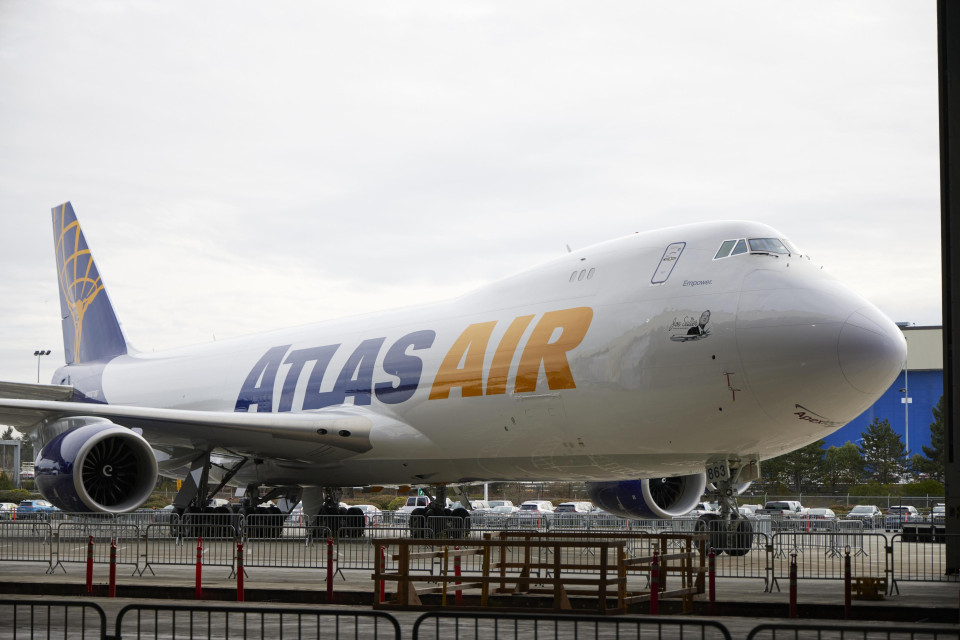Boeing Co. delivered the last unit of its decades-long staple 747 model recently, with representatives of a major Japanese airline attending a farewell event as the operator of the most "jumbo jet" planes worldwide.
The U.S. aircraft giant handed over the final 747 unit -- the 1,574th since production began in 1967 -- to U.S. cargo airline Atlas Air Inc. at a factory in Washington state on Jan. 31, packed with thousands of participants.
The airplane "shrank the world, and revolutionized travel and air cargo as the first widebody," Stan Deal, chief of Boeing's commercial airplane business, said. The plane can accommodate more than 500 seats and was the first passenger airplane to have two aisles.

Among the guests on stage was Yuji Akasaka, president of Japan Airlines Co. The Tokyo-based airline has operated a cumulative total of over 110 passenger 747s, more than any other airline in the world.
"Over the years, Boeing and Japan Airlines have continued to work together through the ups and downs of the airline business, partnering through hardship and celebrating success together," Carolyn Corvi, a former senior official of Boeing, told the event.
JAL began flying B-747s from Haneda airport in Tokyo to Honolulu in 1970. All Nippon Airways Co., another major airline in Japan, began using the model in 1979 for some domestic flights.
The Japanese airline giants introduced the double-decker plane to carry passengers, including businesspeople and tourists, more effectively in the 1970s as the country's economy was rapidly growing while arrival and departure slots were limited at major airports in and near Tokyo.
In addition to Haneda, located in a seaside area near downtown Tokyo, Narita airport opened in 1978 to the east of Tokyo, initially with only one runway.

The jumbo jet, which is currently in use for the U.S. presidential Air Force One and was formerly used by Japan for its government jets, had been the star of commercial aircraft known as the "Queen of the Skies."
Toshiro Yajima, an associate professor at Nihon University who specializes in tourism studies, said the use of B-747s by the major airlines helped boost the tourism industry overall in postwar Japan.
"The rapid expansion of major conventional travel agencies such as JTB Corp. and Nippon Travel Agency Co. since the 1970s was undoubtedly a byproduct of mass transportation by the jumbo jet," Yajima said. "Airfares for group tours and package tours have fallen, making overseas travel destinations, including Hawaii, more accessible."
On Aug. 12, 1985, a JAL jumbo jet from Haneda to Osaka crashed into Mt. Osutaka, northwest of Tokyo, killing 520 passengers and crew members.
JAL retired all of the fuel-gobbling four-engine planes by March 2011, and ANA did so by March 2014. Although Deutsche Lufthansa AG of Germany and South Korea's Korean Air Lines Co. are still flying some B-747s, most have been replaced with more fuel-efficient B-787s or other models for passenger transportation.
Meanwhile, jumbo jets are still in use around the world to meet the strong demand for cargo transport. Nippon Cargo Airlines Co. in Japan operates eight 747-8 planes, the final version of the series.
At last month's ceremony, Atlas Air CEO John Dietrich said, "Our company's history and our success is directly linked to the 747 platform."
The final 747 unit delivered to Atlas Air was in the 747-8 cargo fleet with a length of 76.2 meters, the longest commercial aircraft in operation.

 By Keiichiro Otsuka,
By Keiichiro Otsuka,








